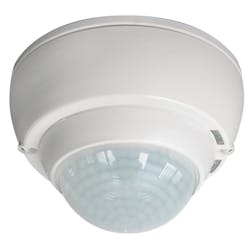DALI-2 brings new functionality to DALI lighting control systems by standardizing devices such as application controllers and inputs. As TIM WHITAKER and SCOTT WADE explain, DALI-2 certification will also lead to improved interoperability.
Digital addressable lighting interface (DALI), the digital lighting control protocol, is currently going through a period of significant change, which will see the introduction of the first DALI-2 certified products, as well as the first standardized DALI control devices such as occupancy sensors and application controllers. Although core parts of the DALI-2 standard were published by the IEC in late 2014, and more have been added or are in development, the process for testing and certifying products has lagged behind. Various lighting companies decided to speed things up by forming the Digital Illumination Interface Alliance (DiiA), an open consortium which is now the key organization for promoting DALI on a global basis. DiiA has launched a DALI-2 certification program, while also continuing to enable member companies to test products according to the original DALI standard.
Interested in articles & announcements on certifications and standards?
Many of the first DALI-2 certified products are likely to be LED drivers (or, in IEC language, control gear for LED modules). In due course, these will be joined by drivers enabling color control; control gear for self-contained emergency lighting; application controllers; and input devices such as light sensors and occupancy sensors. Meanwhile, a DALI wireless network is also on the horizon.
Why DALI?
As standardized in IEC 62386, DALI is a dedicated protocol for lighting control that enables the easy installation of robust, scalable, and flexible lighting networks. It was originally developed to allow digital control, configuration, and querying of fluorescent ballasts, replacing the simple, one-way, broadcast-like operation of 0/1–10V analog control. With DALI, the broadcast option is also available. In addition, with simple configuration, each DALI device can be assigned a separate address, allowing digital control of individual devices. Furthermore, the DALI devices can also be programmed to operate in groups. This provides excellent flexibility since the lighting systems can be reconfigured by software reprogramming, without the need to change the wiring. Different lighting functions and moods can be achieved in different rooms or areas of a building, and then easily adjusted and optimized.
The digital nature of DALI allows two-way communication between devices, so a device can report a failure, answer a query about its status, or provide other information. Wiring is relatively simple; DALI power and data is carried by the same pair of wires, without the need for a separate bus cable. The polarity of the wires does not have to be observed, in contrast with 0/1–10V systems where wiring errors are common.
DALI version 2
So what is DALI-2? The term refers to version 2 of IEC 62386, the international DALI standard. In fact, this standard has many different parts, and not all of these are currently published as version 2. We'll return to this later. One of the key differences between DALI-2 and version 1 of IEC 62386, which has been in use for many years, is the incorporation in DALI-2 of control devices. These include application controllers — the "brains" of a DALI system — and input devices of different types. To enable the incorporation of control devices, other parts of IEC 62386 were restructured and improved to make them both more robust and easier to use.
The first parts of the DALI-2 standard were published almost 3 years ago, and more parts are being added. Meanwhile, an additional piece of the puzzle fell into place in July of this year, with the launch of the DALI-2 certification program by DiiA. This organization was established in response to industry requests for an independently- verified DALI-2 certification program, which had been promised for several years. Until recently, the main proponent of DALI was a working party established by ZVEI, the German Electrical and Electronic Manufacturers' Association. Known as DALI-AG, this organization was dissolved by ZVEI in early 2017. DiiA acquired the DALI trademarks from ZVEI, including the DALI version-1 and DALI-2 logos, as well as the DALI wordmark for use in lighting applications. These trademarks are now available for use by DiiA members.
The original DALI logo is used widely throughout the global lighting industry to indicate products that are in compliance with the older version 1 of the DALI standard. This logo usage will continue in the short term. However, DALI version-1 compliance testing is based on self-declaration by manufacturers, which means that the test results are not independently verified. Also, testing is based on the older, outdated versions of IEC 62386, and the testing procedures have various gaps. For both of these reasons, there can be interoperability issues in the field for DALI version-1 products from different manufacturers.
In contrast, DALI-2 certification involves a verification step, in which the test results are checked to confirm that the correct tests have been carried out, and that the results are all successful.
Interoperability
DALI-2 certification brings the promise of significantly improved interoperability, meaning there is a much greater likelihood that certified DALI-2 products are interoperable with each other. DALI-2 test sequences — the software that enables testing on approved test equipment — are much more detailed than for DALI version-1, and fill in many of the gaps that can cause interoperability problems.
With this significantly improved interoperability, use of DALI-2 certified products will undoubtedly result in far fewer problems in lighting systems. DiiA will help its members to check the interoperability of their products with those of other companies by organizing interoperability events known as Plugfests. Each company will bring products that can be built into systems of control gear and control devices from other companies, to check if the products work together as intended.
Test sequences
The DALI standard, IEC 62386, is divided into a number of parts, and each part requires a set of test sequences for compliance testing, which is carried out either by the manufacturer or by a test house. Successful test results are independently verified by DiiA before DALI-2 certification is granted.
The DALI-2 certification program commenced with parts 101 and 102 of IEC 62386, which contain general requirements for system components and control gear, respectively, along with part 207. This describes specific requirements for control gear for LED modules, meaning that most of the first batch of certified DALI-2 products will be LED drivers.
Other parts of the standard will be incorporated into the DALI-2 certification program via the development by DiiA of the required test sequences. The order of delivery for these parts will be determined by DiiA members, who in turn are influenced by market demand.
Test sequences for part 209, covering color control, are already in the works. Once 209 is added to the DALI-2 program, it will be possible to certify an LED driver that can control the color output of an LED lamp or luminaire. To do this, the testing must include parts 101 and 102 (general), part 207 (LED drivers), and part 209 (color control).
Test sequences for part 103 — general requirements for control devices — are now being developed, checked, and enhanced by DiiA. These will be joined by parts 301–304, which will enable certification of various input devices; for example, part 303 covers occupancy sensors, and part 304 covers light sensors.
Test sequences are based on the most recent versions of the corresponding parts of IEC 62386, whether these are published by IEC or still in development. Because of the way the DALI-2 standard is structured, DiiA is able to develop and update the test sequences independently. Meanwhile, IEC continues the work of updating IEC 62386 and creating new parts of the DALI-2 standard.
Control devices
As stated previously in this article, DALI-2 introduces the possibility of compliance testing for control devices, which was not possible with version 1 of the DALI standard. Looking forward, the market will soon see the release of a variety of certified DALI-2 control devices.
Control devices can be separated into application controllers and input devices, although both device types can be incorporated in the same product. Application controllers are the brains of a DALI system; they gather information, make decisions, and send commands to control gear and other devices. Application controllers can be single masters — where only one is allowed on the DALI bus — or they can be multi-masters. Input devices provide information to the DALI system, and usually operate by sending a message on the DALI bus to indicate a change in state or measurement value. All input devices are multi-masters; examples include push-buttons, light sensors and occupancy sensors.
Color control and wireless
Color control of lamps and luminaires has many applications; it can enable the optimization of color temperature of white lighting, for example, in offices and commercial buildings, as well as mood lighting and scene setting in high-end architectural projects. DALI color control is already covered by part 209 of IEC 62386, which defines four color types, but IEC has plans to separate the two most popular types into separate parts for ease of use. These are xy chromaticity, which allows selection of a color within the CIE 1931 chromaticity diagram, and color temperature (Tc), which allows selection of the correlated color temperature with reference to the black-body line.
And what about wireless? A new part 104 of IEC 62386 is under development, and is based on replacing the lower layers of the protocol stack that are currently described in the system part (101) of IEC 62386. Bluetooth Mesh or other wireless technologies are possible candidates. Most of the DALI protocol will be retained, maintaining the major DALI advantages: control, configuration, and querying. Instead of trying to wirelessly connect two or more wired DALI devices, the DALI-wireless proposal is for control gear and control devices to connect directly to the wireless mesh.
TIM WHITAKER is marcom manager and SCOTT WADE is technical & certification manager for the Digital Illumination Interface Alliance (DiiA; digitalilluminationinterface.org).
*Updated October 3, 2017 at 2:52pm for clarification on interoperability.








